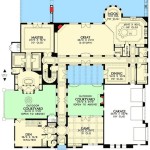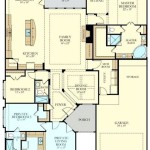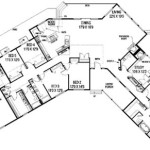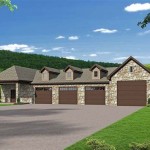House Plans With Walkout Basements: Maximizing Space and Value
House plans with walkout basements represent a significant design choice that can greatly enhance a property's functionality, value, and overall appeal. These plans are particularly well-suited for homes built on sloping lots, allowing for the utilization of what would otherwise be an inaccessible or limited-use space. A walkout basement, characterized by at least one wall being entirely above ground with an exterior door, effectively transforms the basement into a usable living area with direct access to the outdoors.
The popularity of house plans incorporating walkout basements stems from their versatility. They can be adapted for a variety of purposes, from in-law suites and home offices to recreational areas and additional bedrooms. The ability to walk directly outside from the basement level also provides numerous advantages, including improved natural light, ventilation, and emergency egress. Selecting a house plan with a walkout basement requires careful consideration of site conditions, design options, and construction requirements.
Understanding the Advantages of Walkout Basements
The key advantage of a walkout basement lies in its ability to transform a typically dark and underutilized space into a valuable and functional part of the home. Unlike traditional basements, which are often entirely or partially below ground level, a walkout basement has at least one exterior wall that is fully exposed. This allows for the installation of windows and doors, providing natural light, ventilation, and direct access to the backyard or surrounding landscape. This feature fundamentally changes the character of the basement, making it feel more like a ground-floor living space.
Another significant benefit is the increased property value that a walkout basement can add. Finished basements, in general, contribute to the total square footage of a home, and a walkout basement, due to its accessibility and enhanced usability, is often viewed as particularly desirable by potential buyers. It provides additional living space without requiring an expansion of the home's footprint, which can be especially valuable in areas with limited lot sizes or strict zoning regulations.
The flexibility of a walkout basement is also a major draw. It can be customized to suit a wide range of needs and lifestyles. Homeowners might choose to create a separate living area for extended family members, a dedicated home office space, a recreational room for entertainment, or simply additional bedrooms and bathrooms. The presence of an exterior entrance also allows for the creation of an independent dwelling unit, which can be used for rental income or as a guest suite.
Key Design Considerations for Walkout Basement House Plans
Designing a house plan with a walkout basement requires careful planning and attention to detail. The slope of the lot is a primary factor in determining the feasibility and design of the basement. A gentle slope is ideal, as it allows for a gradual transition from the basement level to the surrounding grade. However, even steeper slopes can be accommodated with proper grading and retaining wall construction.
The placement of windows and doors is crucial for maximizing natural light and ventilation. Large windows and sliding glass doors are typically incorporated into the walkout wall to provide ample sunlight and easy access to the outdoors. The orientation of the house should also be considered to optimize solar gain and minimize heat loss. Strategically placed windows can capture passive solar energy during the winter months, while ample shading can help to keep the basement cool during the summer.
Proper drainage is essential to prevent water damage and maintain a dry and comfortable basement environment. A well-designed drainage system should be implemented to effectively manage rainwater and groundwater runoff. This may include grading the surrounding landscape to direct water away from the foundation, installing a perimeter drainage system with perforated pipes, and applying a waterproof membrane to the exterior walls.
Furthermore, the interior layout of the walkout basement should be carefully planned to maximize functionality and livability. Considerations should be given to the placement of staircases, hallways, and doorways to ensure efficient traffic flow. The location of mechanical systems, such as the furnace and water heater, should also be carefully considered to minimize noise and maximize usable space. Thoughtful planning of the interior space ensures the walkout basement is not just an add-on, but rather an integral part of the house.
Construction Aspects and Challenges of Walkout Basements
Building a house with a walkout basement involves specific construction techniques and considerations that differ from those of traditional basements or slab-on-grade foundations. The excavation process is more complex, as it requires careful grading and sloping of the site to create the walkout area. Retaining walls may be necessary to support the surrounding soil and prevent erosion, particularly on steeper slopes. The foundation walls must be properly reinforced and waterproofed to withstand the pressure of the surrounding soil and prevent water infiltration.
One of the significant challenges in constructing a walkout basement is managing moisture. Water infiltration can lead to a variety of problems, including mold growth, structural damage, and reduced indoor air quality. To mitigate these risks, it is crucial to implement comprehensive waterproofing measures. This includes applying a waterproof coating to the exterior foundation walls, installing a perimeter drainage system, and ensuring proper grading of the surrounding landscape.
Another important consideration is insulation. Basements are typically cooler than the upper levels of a house, so proper insulation is essential to maintain a comfortable temperature and reduce energy costs. Insulation can be applied to the interior or exterior walls of the basement, and it should be selected based on the climate and the specific needs of the homeowner. Additionally, insulating the basement floor can help to prevent heat loss and improve comfort.
Finally, ensuring proper ventilation is critical for maintaining a healthy indoor environment in a walkout basement. Adequate ventilation helps to remove excess moisture and prevent the buildup of pollutants. This can be achieved through the installation of windows and doors that can be opened for natural ventilation, as well as the use of mechanical ventilation systems, such as exhaust fans and air exchangers. The integration of natural and mechanical ventilation contributes significantly to the ongoing comfort and air quality within the walkout basement.
Beyond the technical aspects, adhering to local building codes and regulations is paramount during the design and construction phases. These codes often dictate specific requirements for foundation design, waterproofing, insulation, and ventilation, and it is essential to work with experienced professionals who are familiar with these regulations. Compliance with building codes ensures the safety and durability of the structure and avoids potential legal issues down the line.
The initial cost of constructing a house with a walkout basement can be higher than building on a flat lot with a standard foundation. The additional excavation, grading, and retaining wall construction can add significantly to the overall project cost. However, the long-term benefits of having a walkout basement, including increased living space, enhanced property value, and improved livability, often outweigh the initial investment. Furthermore, the ability to potentially generate rental income from a separate basement suite can further offset the initial construction costs.
In summary, house plans with walkout basements offer a compelling solution for homeowners seeking to maximize space, enhance property value, and improve the overall functionality of their homes. While careful planning, design, and construction are essential, the benefits of a well-executed walkout basement can be substantial, transforming a typically underutilized space into a valuable and integral part of the home.

Walkout Basement House Plans To Maximize A Sloping Lot Houseplans Blog Com

Modern Farmhouse Plan W Walkout Basement Drummond House Plans

Walkout Basement House Plans With Photos From Don Gardner Houseplans Blog Com

Don Gardner Walkout Basement House Plans Blog Eplans Com

House Plan 3 Bedrooms 2 5 Bathrooms 3992 V3 Drummond Plans

Small Cottage Plan With Walkout Basement Floor

Plan 80945 A Frame House With Walk Out Basement

Cost Effective Craftsman House Plan On A Walkout Basement 25683ge Architectural Designs Plans

Don Gardner Walkout Basement House Plans Blog Eplans Com

Small Cottage Plan With Walkout Basement Floor








